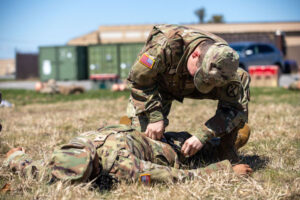
Story by Pfc. Alyssa Norton
27th Public Affairs Detachment
Combat medics with the 10th Combat Aviation Brigade honed their lifesaving skills during brigade combat team tactical trauma (BCT3) training April 22-26 at Fort Drum.
BCT3 properly teaches in a controlled environment how to manage trauma successfully while being put into stressful situations. It also works on medical skills Soldiers predominantly don’t always get to use.
To begin BCT3, Soldiers will take refresher courses on basic medical knowledge and “what-if” scenarios that they may encounter in their careers.
Combat medics are the first line of care when it comes to Soldiers’ health, so BCT3 covers not only refresher courses, but also teaches them the newest studies that the Army has developed so they are constantly on the forefront of casualty care.
“BCT3 is meant to reassure and reinforce their trauma training knowledge, as well as their abilities to handle trauma and stressful conditions,” said Sgt. 1st Class Travis Snyder, an instructor of BCT3 with C Company, 187th Medical Battalion, 32nd Medical Brigade, Medical Center of Excellence.
The training then progresses to Soldiers applying tourniquets and nasopharyngeal airway breathing devices and practicing circulation management skills.
“By doing this training, we expose them to a lot of situations, worst-case scenario situations,” said Staff Sgt. Ryan Zornimer, a BCT3 instructor with C Company, 187th Medical Battalion. “This will allow them to not only gain their experience, but they’ll have that confidence in conjunction with that competence to really perform their duties.”
All the small events lead to the final day of training where the Soldiers will participate in trauma lanes. The trauma lanes are a simulated field lane where the medics will have to apply all their training into one event.
“There (have) been some tasks that I thought I was already optimized in, and then I realized that there’s still room for efficiency,” said Sgt. Joshua Cailer, a brigade team trauma training student from 2nd Battalion, 10th Aviation Regiment, 10th Combat Aviation Brigade. “And I genuinely feel confident of applying it to a real-world setting.”